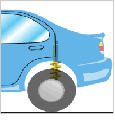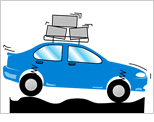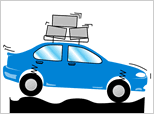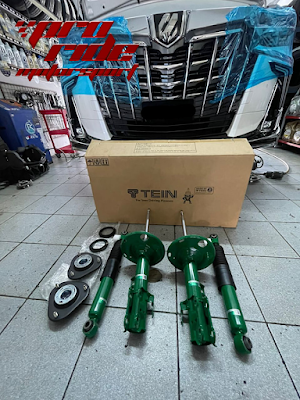Shock Absorbers and your Car
Gravity and weight will keep your tires on the ground… until you hit a bump. And, your vehicle may seem stable and ride evenly… until you swerve, brake or turn.
 The shock absorber regulates the movement of the spring and is the final crucial link in ensuring a smooth and more importantly safe ride. Even with new tires and new brakes, unless all shock absorbers are in good working order vehicle safety is compromised because of reduced wheel contact with the road.
The shock absorber regulates the movement of the spring and is the final crucial link in ensuring a smooth and more importantly safe ride. Even with new tires and new brakes, unless all shock absorbers are in good working order vehicle safety is compromised because of reduced wheel contact with the road.
 With springs but no shock absorbers, the vehicle is able to absorb bumps, but the undampened suspension means that the vehicle continues to bounce and causes the tires to leave the road.
With springs but no shock absorbers, the vehicle is able to absorb bumps, but the undampened suspension means that the vehicle continues to bounce and causes the tires to leave the road.
 With springs and shock absorbers, the vehicle not only absorbs bumps but also the shock absorbers dampen the springs and prevent the vehicle from bouncing.
With springs and shock absorbers, the vehicle not only absorbs bumps but also the shock absorbers dampen the springs and prevent the vehicle from bouncing.
What shocks and struts do? They keep the tires from bouncing which causes loss of road contact and they also keep the vehicle body weight from shifting and rolling which causes a loss of vehicle control and handling. You could say then, that their main job is to resist both tire and vehicle body motion. When shocks and struts are working well, the vehicle maintains traction on the road and has the optimum stability in every driving condition: stopping, turning, swerving, over bumps and potholes.
How do they do that? A shock or a strut operate the same but mount differently. Each of the four tires has either a shock or strut connected to that corner’s suspension and vehicle body or frame. They are hydraulic cylinders that provide motion damping by restricting fluid flow through a series of internal valves. As the wheel and body moves up and down, the shock valving slows and stabilizes the movements.
SHOCKS KEEP YOUR VEHICLE STABLE AND YOU IN CONTROL:
But what is vehicle stability?
Answer: Vehicle stability means being able to stop, turn, and swerve at exactly the moment and in the amount you need. Your shocks react to every wheel and body movement; every bump and every corner.
 The shock absorber regulates the movement of the spring and is the final crucial link in ensuring a smooth and more importantly safe ride. Even with new tires and new brakes, unless all shock absorbers are in good working order vehicle safety is compromised because of reduced wheel contact with the road.
The shock absorber regulates the movement of the spring and is the final crucial link in ensuring a smooth and more importantly safe ride. Even with new tires and new brakes, unless all shock absorbers are in good working order vehicle safety is compromised because of reduced wheel contact with the road. With springs but no shock absorbers, the vehicle is able to absorb bumps, but the undampened suspension means that the vehicle continues to bounce and causes the tires to leave the road.
With springs but no shock absorbers, the vehicle is able to absorb bumps, but the undampened suspension means that the vehicle continues to bounce and causes the tires to leave the road. With springs and shock absorbers, the vehicle not only absorbs bumps but also the shock absorbers dampen the springs and prevent the vehicle from bouncing.
With springs and shock absorbers, the vehicle not only absorbs bumps but also the shock absorbers dampen the springs and prevent the vehicle from bouncing.


Comments